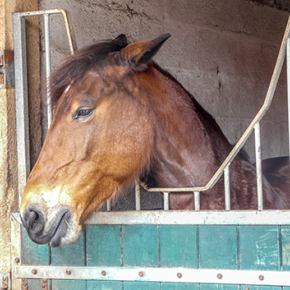
Animal welfare: Potential new indicator of chronic stress in horses
Cortisol is generally considered to be a stress hormone because its levels rise during episodes of acute stress. Yet its relationship to chronic stress is less clear. Researchers from the Éthologie Animale et Humaine laboratory (CNRS / Université de Rennes 1 / Université of Caen) and the Research Institute for Environmental and Occupational Health (INSERM / Université de Rennes 1), in collaboration with the University of Veterinary Medicine in Vienna, have linked lower cortisol levels to states of chronically poor welfare in adult horses observed under their usual living conditions. Their findings are published in PLOS ONE (September 8, 2017).
Cortisol, deemed the quintessential stress hormone, allows us to cope with important events and imminent threats. A spike in cortisol levels mobilizes necessary resources—such as by tapping into our body's reserves to produce energy—and then allows us to return to a stable state. But can our bodies cope with prolonged or repeated stress in the same way? Some studies report lower cortisol levels in humans1
—or other mammals—subject to chronic stress, while other studies contradict these findings. In light of this, is cortisol still a reliable stress indicator?
To answer this question, researchers from Rennes, France, studied 59 adult horses (44 geldings and 15 mares) from three different riding centers, under their usual living conditions: Horses were kept in individual stalls that are both spatially and socially restrictive and rode by unexperienced equestrians—both potential stressors that, if recurrent, can lead to chronically compromised welfare. The scientists monitored various behavioral and sanitary indicators of the horses' welfare and measured cortisol levels using blood and stool samples. The equine subjects had all been living under the stated conditions for at least a year at the start of the study, and they were observed for several weeks.
Surprisingly, cortisol levels in horses showing signs of compromised welfare (e.g., ears pointed back, back problems, and anemia) were lower than in other horses. These findings are in accord with early observations by the ethology team, which recorded abnormally low cortisol concentrations in horses with depressive-like behavior.2
Furthermore, cortisol metabolite levels measured in feces correlated with blood cortisol levels, which advocates use of stool sample analyses as an alternative, noninvasive means of gauging horse welfare.
Low cortisol levels may seem counterintuitive here, but they could be explained by a breakdown of the system when horses experience stress at excessive levels for excessive lengths of time. So when exactly does duration and intensity of stress become excessive for these horses? This is one of the questions the team of researchers is now seeking to answer. At any rate, this study demonstrates that cortisol levels are not always reliable indicators of stress or compromised welfare: On the one hand, high cortisol may be a sign of positive stress, driving higher performance; on the other, low cortisol does not necessarily mean lack of stress. Quite the contrary, under a certain threshold, low cortisol levels may be cause for concern.

Horse exhibiting depressive-like behavior.
The horse is “withdrawn” (neck lowered, immobile) and indifferent to the environment, as suggested by its position, facing the wall.
Like humans, horses work every day, which may have both physical and psychological consequences.

Horse with ears pointing back, a potential sign of compromised welfare
In this study, horses were deemed to be in states of chronically compromised welfare when three of the four following signs were observed: (1) ears cocked back more than half the time, (2) vertebral problems, (3) anemia, and (4) an abnormally high neutrophil count.
- 1This has been observed in people suffering from burnout or chronic back pain, for example. Juster RP, Sindi S, Marin MF, Perna A, Hashemi A, Pruessner JC, et al. A clinical allostatic load index is associated with burnout symptoms and hypocortisolemic profiles in healthy workers. Psychoneuroendocrinology. 2011;36(6):797-805. Muhtz C, Rodriguez-Raecke R, Hinkelmann K, Moeller-Bertram T, Kiefer F, Wiedemann K, et al. Cortisol response to experimental pain in patients with chronic low back pain and patients with major depression. Pain Med. 2013;14(4):498-503.
- 2These horses are apathetic: they experience periods of immobility, “withdrawn” behavior, and unresponsiveness to environmental stimuli. (Fureix C, Jego P, Henry S, Lansade L, Hausberger M. Towards an ethological animal model of depression? A study on horses. PLOS ONE. 2012 Jun 28. View web site)
Low plasma cortisol and fecal cortisol metabolite measures as indicators of compromised welfare in domestic horses, Jodi Pawluski, Patrick Jego, Séverine Henry, Anaelle Bruchet, Rupert Palme, Caroline Coste & Martine Hausberger. PLOS ONE, 8 September 2017. View web site


